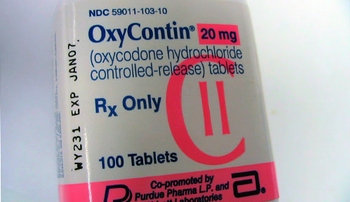In a recent Omaha World-Herald article, a Nebraska State Patrol investigator called prescription drug abuse an “epidemic” in the state.
Aly Hassan, M.D., assistant professor of psychiatry in the College of Medicine, agrees. “Clinically, it’s a very common problem,” Dr. Hassan said.
But why is this happening now?
 |
Prescriptions for Oxycontin and other pain medications surged after the medical world sharpened it focus on pain treatment in the 1990s. The increase in pain medication prescriptions has been a major contributing factor in the epidemic level of abuse of and addiction to such drugs. |
Part of it, Dr. Hassan said, is that we treat pain differently today.
“Remember, the nineties was the decade of treatment of pain,” Dr. Hassan said. There was a shift in medicine, a change in policy. “An important aspect of that was to consider pain as the fifth vital sign.”
Rate your pain
You’ll see it often in doctors’ offices and clinics: signs on the wall that urge you to rank your discomfort from 1-10.
And there’s good reason for that, Dr. Hassan said. Pain is a serious thing, and should be treated as such.
“The experience of pain is not only somatic. It’s not just the nerve being stimulated,” Dr. Hassan said. Acute pain can affect not just quality of life, but quality of health. You can even see it in a person’s vital signs.
“When you solve acute pain, all that tends to normalize,” Dr. Hassan said.
The wave begins
It’s no wonder the medical field started to emphasize the treatment of pain. But with that came a lot of drugs.
In 2011, Hydrocodone — a narcotic — was the most prescribed drug in America, according to WebMD.
Addiction issue not foreseen
At first many in the medical community were not worried about drug addiction.
“The pain patient can be treated with narcotics with little risk of developing the self-destructive behavior characteristic of addiction,” concluded a 1990 report “The Use of Narcotics for the Treatment of Chronic Pain,” by the Sacramento-El Dorado Medical Society.
Perfectly suited for addiction
But, Dr. Hassan noted in 2012, the makeup of many of these drugs are compatible with addiction in that they absorb very fast, and the half-life of the medicine staying in your system goes very fast. And then you want another.
“The opiates are very addictive for that reason,” Dr. Hassan said.
At a crossroads
Physicians are in a tough spot. That doesn’t absolve them of responsibility.
But, “This is beyond the level of an individual practitioner,” Dr. Hassan said. “This is really a state problem or even a national problem.”